Parkside PMGS 12 A1 User Manual
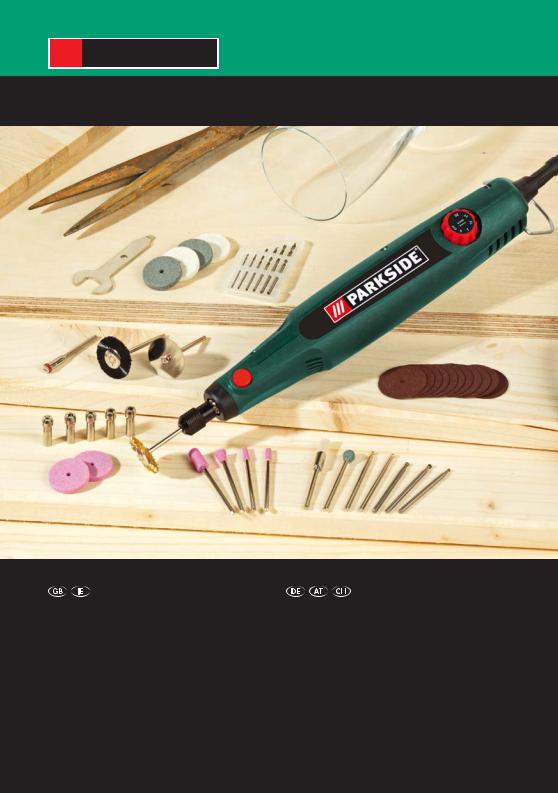
MODELLING AND ENGRAVING SET PMGS 12 A1
|
|
MODELLING AND |
MODELLBAUUND GRAVIERSET |
ENGRAVING SET |
Bedienungsund Sicherheitshinweise |
Operation and Safety Notes |
Originalbetriebsanleitung |
Translation of original operation manual |
|
6 

Before reading, unfold the page containing the illustrations and familiarise yourself with all functions of the device.
Klappen Sie vor dem Lesen die Seite mit den Abbildungen aus und machen Sie sich anschließend mit allen Funktionen des Gerätes vertraut.
GB / IE |
Operation and Safety Notes |
Page |
5 |
DE / AT / CH |
Bedienungsund Sicherheitshinweise |
Seite |
15 |
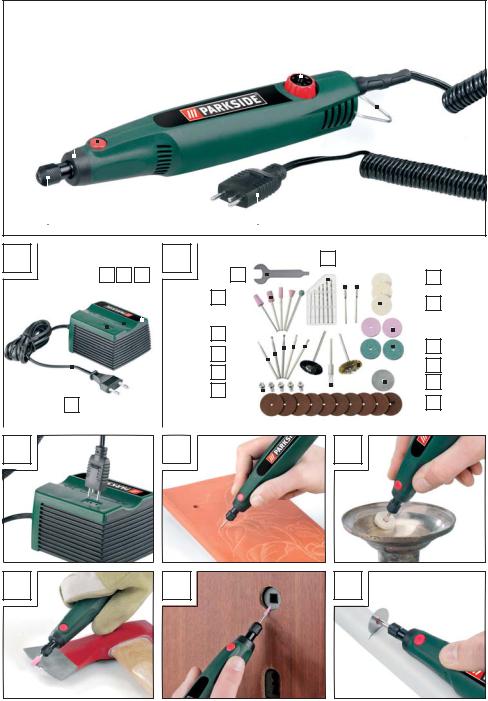
5 |
|
6 |
|
1 |
|
2 |
||||
|
|
|
|
|
|
|
|
|
|
|
|
|
|
|
|
|
|
|
|
|
|
|
|
|
|
|
|
|
|
|
|
|
|
|
|
|
|
|
|
|
|
|
|
|
|
|
|
|
|
|
|
|
|
4 |
|
3 |
||
A |
|
|
|
|
|
|
|
|
|
|
|
|
|
|
B |
|
|
|
|
|
|
|
|
|
|
|
|
|
|
|
|
|
|
|
|
|
|
|
|
|
|
|
|
|
|
|
|
|
|
|
|
|
|
|
|
|
|
|
|
|
|
|
|
|
|
|
|
|
|
|
|
|
|
|
|
|
|
|
|
|
|
|
|
|
|
|
|
|
|
||||
|
|
|
|
|
|
|
|
|
|
|
|
|
|
|
|
|
|
|
|
|
|
|
|
|
|
|
|
|
11 |
|
|
|
|
|
|
|
|
|
|
|
|
|||||
|
|
7 |
|
8 |
|
9 |
|
|
23 |
|
|
|
|
|
|
|
|
|
|
|
||||||||||||||||||||||||||
|
|
|
|
|
|
|
|
|
|
|
|
|
|
|
|
|
|
|
|
|
12 |
|
||||||||||||||||||||||||
|
|
|
|
|
|
|
|
|
|
|
|
|
|
|
|
|
|
|
|
|
|
|||||||||||||||||||||||||
|
|
|
|
|
|
|
|
|
|
|
|
|
|
|
|
|
|
|
|
|
|
|
|
|
|
|
|
|
|
|
|
|
|
|
|
|
|
|
|
|
|
|
|
|
|
|
|
|
|
|
|
|
|
|
|
|
|
|
|
|
|
|
|
|
|
|
|
|
|
|
|
|
|
|
|
|
|
|
|
|
|
|
|
|
|
|
|
|
|
|
|
|
|
|
|
|
|
|
|
|
|
|
|
|
|
|
|
|
|
22 |
|
|
|
|
|
|
|
|
|
|
|
|
|
|
|
|
|
|
|
|
|
|
|
|
|
|
|
|||
|
|
|
|
|
|
|
|
|
|
|
|
|
|
|
|
|
|
|
|
|
|
|
|
|
|
|
|
|
|
|
|
|
|
|
|
13 |
|
|||||||||
|
|
|
|
|
|
|
|
|
|
|
|
|
|
|
|
|
|
|
|
|
|
|
|
|
|
|
|
|
|
|
|
|
|
|
|
|
|
|
|
|||||||
|
|
|
|
|
|
|
|
|
|
|
|
|
|
|
|
|
|
|
|
|
|
|
|
|
|
|
|
|
|
|
|
|
|
|
|
|
|
|
|
|
|
|
|
|
||
|
|
|
|
|
|
|
|
|
|
|
|
|
|
|
|
|
|
|
|
|
|
|
|
|
|
|
|
|
|
|
|
|
|
|
|
|
|
|
|
|
|
|
|
|
|
|
|
|
|
|
|
|
|
|
|
|
|
|
|
|
|
|
|
|
|
|
|
|
|
|
|
|
|
|
|
|
|
|
|
|
|
|
|
|
|
|
|
|
|
|
|
|
|
|
|
|
|
|
|
|
|
|
|
|
|
|
|
|
|
21 |
|
|
|
|
|
|
|
|
|
|
|
|
|
|
|
|
|
|
|
|
|
|
|
|
|
|
|
|||
|
|
|
|
|
|
|
|
|
|
|
|
|
|
|
|
|
|
|
|
|
|
|
|
|
|
|
|
|
|
|
|
|
|
|
|
|
|
|
|
|
|
|||||
|
|
|
|
|
|
|
|
|
|
|
|
|
|
|
|
|
|
|
|
|
|
|
|
|
|
|
|
|
|
|
|
|
|
|
|
|
|
|
|
|
|
|
|
14 |
|
|
|
|
|
|
|
|
|
|
|
|
|
|
|
|
|
|
|
|
20 |
|
|
|
|
|
|
|
|
|
|
|
|
|
|
|
|
|
|
|
|
|
|||||||
|
|
|
|
|
|
|
|
|
|
|
|
|
|
|
|
|
|
|
|
|
|
|
|
|
|
|
|
|
|
|
|
|
|
|
|
|
|
|
|
|
|
|
||||
|
|
|
|
|
|
|
|
|
|
|
|
|
|
|
|
|
|
|
|
|
|
|
|
|
|
|
|
|
|
|
|
|
|
|
|
|
|
|
|
|
|
|
||||
|
|
|
|
|
|
|
|
|
|
|
|
|
|
|
|
|
|
|
|
|
|
|
|
|
|
|
|
|
|
|
|
|
|
|
|
|
|
|
|
|
|
|
|
15 |
|
|
|
|
|
|
|
|
|
|
|
|
|
|
|
|
|
|
|
|
19 |
|
|
|
|
|
|
|
|
|
|
|
|
|
|
|
|
|
|
|
|
|
|
||||||
|
|
|
|
|
|
|
|
|
|
|
|
|
|
|
|
|
|
|
|
|
|
|
|
|
|
|
|
|
|
|
|
|
|
|
|
|
|
|
|
16 |
|
|||||
|
|
|
|
|
|
|
|
|
|
|
|
|
|
|
|
|
|
|
|
|
|
|
|
|
|
|
|
|
|
|
|
|
|
|
|
|
|
|
|
|
|
|
|
|
||
|
|
|
|
|
|
|
|
|
|
|
|
|
|
|
|
|
|
18 |
|
|
|
|
|
|
|
|
|
|
|
|
|
|
|
|
|
|
|
|
|
|
|
|
|
|||
|
|
|
|
|
|
|
|
|
|
|
|
|
|
|
|
|
|
|
|
|
|
|
|
|
|
|
|
|
|
|
|
|
|
|
|
|
|
|
|
|
|
|
||||
|
|
|
|
|
|
|
|
|
|
|
|
|
|
|
|
|
|
|
|
|
|
|
|
|
|
|
|
|
|
|
|
|
|
|
|
|
|
|
|
|
|
|||||
|
|
10 |
|
|
|
|
|
|
|
|
|
|
|
|
|
|
|
|
|
|
|
|
|
|
|
|
|
|
|
|
|
|
|
|
|
|
|
|
|
|
17 |
|
||||
|
|
|
|
|
|
|
|
|
|
|
|
|
|
|
|
|
|
|
|
|
|
|||||||||||||||||||||||||
|
|
|
|
|
|
|
|
|
|
|
|
|
|
|
|
|
|
|
|
|
|
|
|
|
|
|
|
|
|
|
|
|
|
|
|
|
|
|
|
|
|
|
|
|
|
|
|
|
|
|
|
|
|
|
|
|
D |
|
|
|
|
|
|
|
|
|
|
|
|
|
|
|
|
|
|
|
|
|
|
|
|
||||||||||||
C |
|
|
|
|
|
|
|
E |
||||||||||||||||||||||||||||||||||||||
F |
G |
H |

Table of contents
Introduction |
|
|
Proper use...................................................................................................................... |
Page |
6 |
Features and equipment ............................................................................................... |
Page |
6 |
Included items ............................................................................................................... |
Page |
7 |
Technical information.................................................................................................... |
Page |
7 |
General safety advice for electrical power tools.................. |
Page |
7 |
1. Workplace safety ..................................................................................................... |
Page |
8 |
2. Electrical safety ......................................................................................................... |
Page |
8 |
3. Personal safety.......................................................................................................... |
Page |
8 |
4. Careful handling and use of electrical power tools ............................................... |
Page |
9 |
Device-specific safety instructions for small drill KH3037 |
|
|
and mains adapter KH3037-1 .................................................................................... |
Page |
9 |
Operation |
|
|
Inserting or replacing a tool / collet ............................................................................. |
Page |
10 |
Switching on and off / Setting the speed range.......................................................... |
Page 10 |
|
Advice on working with materials / Tools / Speed ranges ......................................... |
Page 11 |
|
Tips and tricks................................................................................................................ |
Page 11 |
|
Maintenance and cleaning......................................................................... |
Page 11 |
|
Service ......................................................................................................................... |
Page 12 |
|
Warranty................................................................................................................... |
Page 12 |
|
Disposal ...................................................................................................................... |
Page 12 |
|
Manufacturer’s Declaration of |
|
|
Conformity / Manufacturer......................................................................... |
Page 13 |
|
GB/IE 5
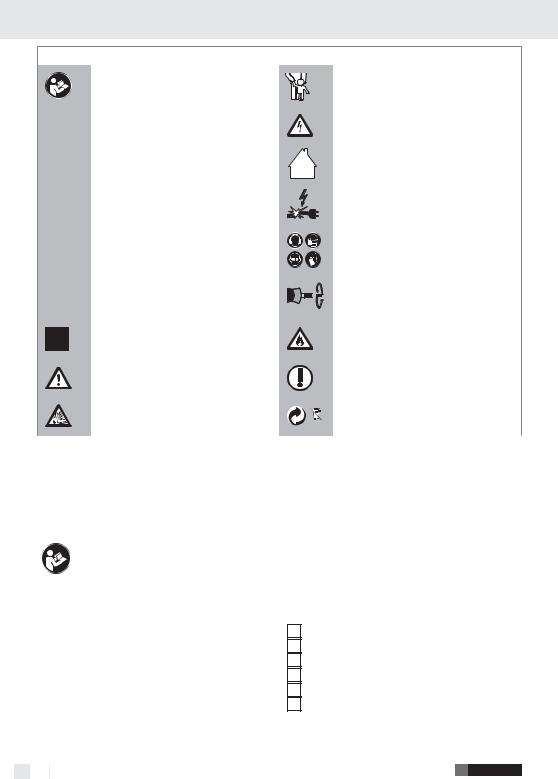
Introduction
The following pictograms are used in these operating instructions / on the device:
|
|
|
|
|
|
|
|
|
Read instruction manual! |
|
|
|
|
|
|
|
|
|
|
|
Keep children away from electrical |
|
|
|
|
|
|
|
|
|
|
|
|
|
|
|
|
|
|
|
|
|
power tools! |
||
|
|
|
|
|
|
|
|
|
|
|
|
|
|
|
|
|
|
|
|
|
|
|
|
|
|
|
|
|
|
|
|
|
|
|
|
|
|
|
|
|
|
|
|
|
|
V~ |
|
Volt (AC) |
|
|
|
|
|
|
|
|
|
|
|
Caution – electric shock! |
||||||||
|
|
|
|
|
|
|
|
|
|
|
|
Danger to life! |
||||||||||
|
|
|
|
|
|
|
|
|
|
|
|
|
|
|||||||||
W |
|
Watts (E ective power) |
|
|
|
|
|
|
|
|
|
|
|
For indoor use only! |
||||||||
|
|
|
|
|
|
|
|
|
|
|
|
|
|
|
|
|
|
|
|
|||
|
|
|
|
|
|
|
|
|
|
|
|
|
|
|
|
|
|
|
|
|
|
|
|
|
|
|
|
|
|
|
|
Direct current |
|
|
|
|
|
|
|
|
|
|
|
Risk of loss of life by electric shock from |
|
|
|
|
|
|
|
|
|
|
(Type of current and voltage) |
|
|
|
|
|
|
|
|
|
|
|
damaged mains lead or mains plug! |
|
|
|
|
|
|
|
|
|
|
|
|
|
|
|
|
|
|
|
|
|
|||
|
|
|
|
|
|
|
|
|
|
|
|
|
|
|
|
|
|
|
|
|
|
|
n0 |
|
|
|
|
|
|
|
|
|
|
|
|
|
|
Wear hearing protection, dust |
|||||||
|
Design no-load speed |
|
|
|
|
|
|
|
|
|
|
|
protection mask, protective glasses |
|||||||||
|
|
|
|
|
|
|
|
|
|
|
|
|
|
|
|
|
|
|
|
|||
|
|
|
|
|
|
|
|
|
|
|
|
|
|
|
|
|
|
|
|
|
|
and protective gloves. |
|
|
|
|
|
|
|
|
|
|
|
|
|
|
|
|
|
|
|
|
|
|
|
mA |
|
Milliamps / Amps / Amp-hours |
|
|
|
|
|
|
|
|
|
|
|
Avoid contact with rapidly |
||||||||
|
|
|
|
|
|
|
|
|
|
|
|
|||||||||||
A / Ah |
|
|
|
|
|
|
|
|
|
|
|
|
rotating tools! |
|||||||||
|
|
|
|
|
|
|
|
|
|
|
|
|
|
|||||||||
|
|
|
|
|
|
|
|
|
|
|
|
|
|
|
|
|
|
|
|
|
|
|
|
|
|
|
|
|
|
|
|
Safety class II |
|
|
|
|
|
|
|
|
|
|
|
Risk of fire! |
|
|
|
|
|
|
|
|
|
|
|
|
|
|
|
|
|
|
|
|
|
|||
|
|
|
|
|
|
|
|
|
|
|
|
|
|
|
|
|
|
|
|
|
|
|
|
|
|
|
|
|
|
|
|
|
|
|
|
|
|
|
|
|
|
|
|
|
|
|
|
|
|
|
|
|
|
|
Observe caution and safety notes! |
|
|
|
|
|
|
|
|
|
|
|
Proper procedure and handling. |
|
|
|
|
|
|
|
|
|
|
|
|
|
|
|
|
|
|
|
|
|
|
|
|
|
|
|
|
|
|
|
|
|
Risk of explosion!! |
|
|
|
|
|
|
|
|
|
|
|
Dispose packaging and appliance in |
|
|
|
|
|
|
|
|
|
|
|
|
|
|
|
|
|
|
|
|
|
|||
|
|
|
|
|
|
|
|
|
|
|
|
|
|
|
|
|
|
|
|
an environmentally-friendly way! |
||
|
|
|
|
|
|
|
|
|
|
|
|
|
|
|
|
|
|
|
|
|
|
|
|
|
|
|
|
|
|
|
|
|
|
|
|
|
|
|
|
|
|
|
|||
Modelling and engraving set |
and sawing of wood, metal, plastic, ceramic or stone |
|||||||||||||||||||||
PMGS 12 A1 |
in dry rooms. Any other use or modification to the |
|||||||||||||||||||||
|
|
|
|
|
|
|
|
|
|
|
drill / grinder shall be considered as improper use |
|||||||||||
Introduction |
and could give rise to considerable dangers. The |
|||||||||||||||||||||
manufacturer will not accept liability for loss or |
||||||||||||||||||||||
|
|
|
|
|
|
|
|
|
|
|
damage arising from improper use. Not intended |
|||||||||||
|
|
|
|
|
|
|
|
Please make sure you familiarise yourself |
for commercial use. |
|||||||||||||
|
|
|
|
|
|
|
|
|||||||||||||||
|
|
|
|
|
|
|
|
fully with the way the device works before |
|
|
|
|
|
|
|
|
|
|
|
|
||
|
|
|
|
|
|
|
|
you use it for the first time and that you |
Features and equipment |
|||||||||||||
understand how to handle electrical power tools |
||||||||||||||||||||||
correctly. To help you do this please read the accom- |
|
|
|
|
|
|
|
|
|
|
|
|
||||||||||
panying operating instructions. Keep these instructions |
Small drill: |
|||||||||||||||||||||
in a safe place. If you pass the device on to anyone |
|
1 |
|
|
ON / OFF switch / Rotational speed control |
|||||||||||||||||
else, please ensure that you also pass on all the |
|
2 |
|
|
Metal stirrup hanger |
|||||||||||||||||
documentation. |
|
3 |
|
|
Plug for mains adapter |
|||||||||||||||||
|
|
|
|
|
|
|
|
|
|
|
|
4 |
|
|
Clamping nut |
|||||||
Proper use |
|
5 |
|
|
Spigot nut |
|||||||||||||||||
|
6 |
|
|
Spindle lock |
||||||||||||||||||
The small drill is to be used for drilling, milling, engraving, polishing, cleaning up, grinding, separating
6GB/IE

Introduction / General safety advice for electrical power tools
Mains adapter (see Fig. A): |
Evaluated acceleration, typical: |
|||||||
7 |
Plug-in device for plug |
3 |
|
Hand / arm vibration: 1.987 m / s2 |
||||
|
Tray |
Uncertainty K = 1.5 m / s2 |
||||||
8 |
||||||||
9 |
Mains adapter |
|
|
|
|
|||
10 |
Power cable (with mains plug) |
|
|
WARNING! |
The vibration level given in these |
|||
|
|
|
|
|
instructions has been measured in accordance with |
|||
Accessories (see Fig. B): |
a standardised measurement procedure specified |
|||||||
11 |
6 |
HSS drills |
in EN 60745 and can be used to compare devices. |
|||||
12 |
2 |
Mandrels for mounting tools |
Di erent uses of the device give rise to di erent |
|||||
13 |
3 |
Polishing wheels |
vibration levels and in many cases they may exceed |
|||||
14 |
4 |
Grinding wheels |
the values given in these instructions. It is easy to |
|||||
15 |
1 |
Metal brush |
underestimate the vibration load if the electrical pow- |
|||||
16 |
1 |
Saw blade |
er tool is used regularly in particular circumstances. |
|||||
17 |
10 Cutting wheels |
|
|
|
|
|||
18 |
5 |
Collets |
Note: If you wish to make an accurate assessment |
|||||
19 |
2 |
Plastic brushes |
of the vibration loads experienced during a particular |
|||||
20 |
3 |
Milling bits |
period of working, you should also take into account |
|||||
21 |
2 |
Engraving bits |
the intervening periods of time when the device is |
|||||
22 |
5 |
Grinding bits |
switched o or is running but is not actually in use. |
|||||
23 |
Combination tool |
This can result in a much lower vibration load over |
||||||
|
|
|
|
|
the whole of the period of working. |
|||
Included items
1Small drill
1Mains adapter
1Plastic case
1Accessory kit (45-piece)
1Operating instructions
Technical information
Small drill PMGS 12 A1:
Nominal voltage: |
12 V |
|
|
|
|||
Nominal output: |
22 W |
||
Idle-running speed: |
n0 5000 - 20000 min-1 |
||
Max. drill bit diameter: |
3.2 mm |
||
Certified acc. to: |
EN60745-1; EN60745-2-1 |
||
Noise and vibration data:
Measured values for noise are determined in accordance with EN 60745. The A-weighted noise level of the electrical power tool are typically:
Sound pressure level: |
59.43 dB(A) |
Sound power level: |
70.43 dB(A) |
Uncertainty K: |
3 dB |
Mains adapter PMGS 12 A1-1:
INPUT:
Rated voltage:
OUTPUT:
Nominal voltage:
Nominal current:
Protection class:
Certified acc. to:
General safety advice for electrical power tools
 WARNING! Read all the safety advice and instructions! Failure to observe the safety advice and instructions may result in electric shock, fire and / or serious injury.
WARNING! Read all the safety advice and instructions! Failure to observe the safety advice and instructions may result in electric shock, fire and / or serious injury.
Keep all the safety advice and instructions in a safe place for future reference!
The term “electrical tool” used in the safety advice refers to electrical tools powered by mains electricity
GB/IE 7
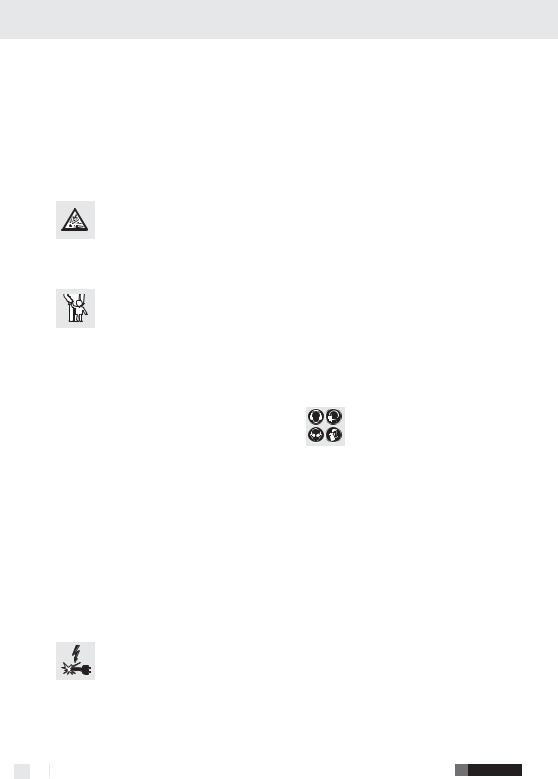
General safety advice for electrical power tools
(by means of a mains lead) and electrical tools powered by rechargeable batteries (without a mains lead).
1. Workplace safety
a)Keep your working area clean and well lit. Untidy or poorly lit working areas can lead to accidents.
b)Do not work with the device
in potentially explosive environments in which there are
inflammable liquids, gases or dusts.
Electrical power tools create sparks, which can ignite dusts or fumes.
c)Keep children and other
people away while you are operating the electrical tool.
Distractions can cause you to lose control of the device.
2. Electrical safety
a)The mains plug on the device must match the mains socket. The plug must not be modified in any way. Do not use an adapter plug with devices fitted with a protective earth. Unmodified plugs and matching sockets reduce the risk of electric shock.
b)Avoid touching earthed surfaces such as pipes, radiators, ovens and refrigerators with any part of your body.
There is an increased risk of electric shock if your body is earthed.
c)Keep the device away from rain or moisture. Water entering an electrical device increases the risk of electric shock.
d)Do not use the mains lead for any purpose for which it was
 not intended, e.g. to carry the device, to hang up the device or to pull the mains plug out of the mains socket. Keep the mains lead away from heat, oil, sharp edges or moving parts of the
not intended, e.g. to carry the device, to hang up the device or to pull the mains plug out of the mains socket. Keep the mains lead away from heat, oil, sharp edges or moving parts of the
device. Damaged or tangled mains leads increase the risk of electric shock.
e)When working outdoors with an electrical power tool always use extension cables that are also approved for use outdoors. The use of an extension cable suitable for outdoor use reduces the risk of electric shock.
f)Use a residual current device (RCD) for protection if operating the electrical power tool in a moist environment is unavoidable. The use of an RCD reduces the risk of electric shock.
3.Personal safety
a)Remain alert at all times, watch what you are doing and always proceed with caution. Do not use the device if you are tired or under the influence of drugs, alcohol or medication. One moment of carelessness when using the device can lead to serious injury.
b)Wear personal protective
equipment and always wear safety glasses. The wearing of
personal protective equipment such as dust masks, non-slip safety shoes, safety helmets or ear protectors, appropriate to the type of electrical power tool used and work undertaken, reduces the risk of injury.
c)Avoid unintentional operation of the device. Check that the electrical power tool is switched off before you connect it to the mains, pick it up or carry it.
Accidents can happen if you carry the device with your finger on the ON / OFF switch or with the device switched on.
d)Remove any setting tools or spanners before you switch the device on. A tool or spanner left attached to a rotating part of a device can lead to injury.
e)Avoid placing your body in an unnatural position. Keep proper footing and balance at all times. By doing this you will be in a better position to control the device in unforeseen circumstances.
8GB/IE
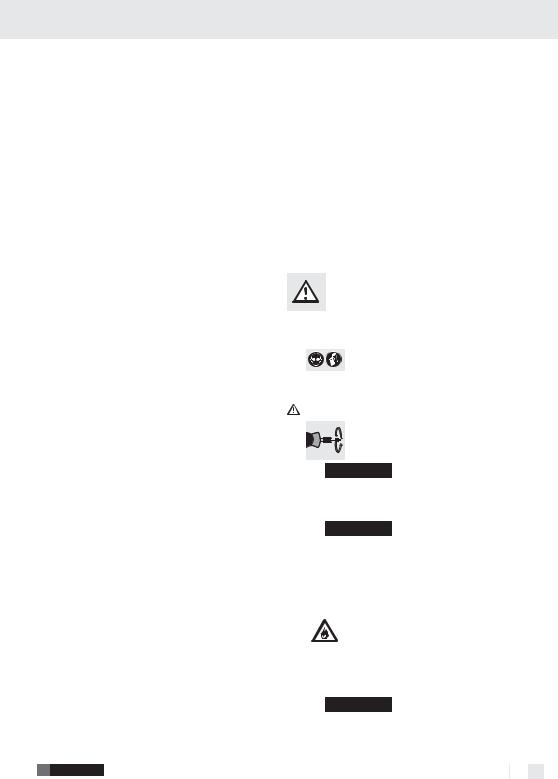
General safety advice for electrical power tools
f)Wear suitable clothing. Do not wear loose clothing or jewellery. Keep your hair, clothing and gloves clear of moving parts. Loose clothing, jewellery or long hair can become trapped in moving parts.
g)If vacuum dust extraction and collection devices are fitted do not forget to check that they are properly connected and correctly used. The use of these devices reduces the hazard presented by dust.
4.Careful handling and use of electrical power tools
a)Do not overload the device. Always use an electrical power tool that is intended for the task you are undertaking. By using the right electrical power tool for the job you will work more safely and achieve a better result.
b)Do not use an electrical power tool if its switch is defective. An electrical power tool that can no longer be switched on and o is dangerous and must be repaired.
c)Pull the mains plug from the socket before you make any adjustments to the device, change accessories or when the device is put away. This precaution is intended to prevent you from unintentionally starting the device.
d)When not in use always ensure that electrical power tools are kept out of reach of children. Do not let anyone use the device if he or she is not familiar with it or has not read the instructions and advice. Electrical power tools are dangerous when they are used by inexperienced people.
e)Look after the device carefully. Check that moving parts are working properly and move freely. Check for any parts that are broken or damaged enough to detrimentally affect the functioning of the device. Have damaged parts repaired before you use the device. Many accidents have their origins in poorly maintained electrical power tools.
f)Keep cutting tools clean and sharp.
Carefully maintained cutting tools with sharp cutting edges are less likely to jam and are easier to control.
g)Use the electrical power tool, accessories, inserted tools etc. in accordance with these instructions and advice, and the stipulations drawn up for this particular type of device. In doing this, take into account the working conditions and the task in hand. The use of electrical power tools for purposes other than those intended can lead to dangerous situations.
Device-specific safety instructions for small drill KH3037 and mains adapter KH3037-1
|
When you use the drill / |
|
grinder wear the following |
|
protective equipment: safety glasses |
|
and protective gloves. |
|
CAUTION! The tool continues to rotate |
|
after it has been switched off! |
|
Avoid contact with rapidly rotating |
|
drill / grinder components. |
 WARNING! Securely support the workpiece. Use clamps or a vice to grip the workpiece firmly. This is much safer than holding it in your hand.
WARNING! Securely support the workpiece. Use clamps or a vice to grip the workpiece firmly. This is much safer than holding it in your hand.
 WARNING! Never support yourself by placing your hands near or in front of the device or the workpiece surface. A slip can result in injury.
WARNING! Never support yourself by placing your hands near or in front of the device or the workpiece surface. A slip can result in injury.
Avoid contact with moving sanding or grinding tools.
|
|
DANGER OF FIRE FROM FLYING |
|
||
|
|
SPARKS! Abrading metal creates |
|
|
flying sparks. For this reason, always |
|
|
|
|
make sure that nobody is placed in any danger |
|
|
and that there are no inflammable materials |
|
|
near the working area. |
|
 WARNING! DUST HAZARD! Any harmful / noxious dusts generated from machining represent a risk to the health of the person
WARNING! DUST HAZARD! Any harmful / noxious dusts generated from machining represent a risk to the health of the person
GB/IE 9
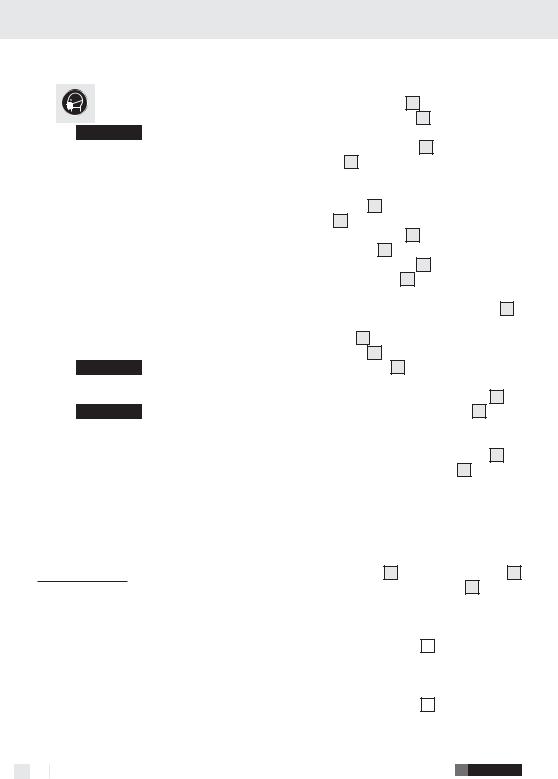
General safety advice for electrical power tools / Operation
operating the device and to anyone near the work area.
Wear a dust mask!
 WARNING! NOXIOUS FUMES!
WARNING! NOXIOUS FUMES!
Ensure that there is adequate ventilation when machining surfaces containing plastic or covered with paint, varnish etc.
Do not soak the materials or the surface you are about to work on with liquids containing solvents.
Avoid abrading paints containing lead or other substances hazardous to health.
Do not machine materials containing asbestos. Asbestos is a known carcinogen.
Do not machine moist materials or damp surfaces.
NOTE! Do not allow the tool to come to a standstill by overloading it!
 WARNING! Switch the device off and allow it to come to a standstill before you put it down.
WARNING! Switch the device off and allow it to come to a standstill before you put it down.
 WARNING! Always keep the device clean, dry and free of oil or grease.
WARNING! Always keep the device clean, dry and free of oil or grease.
Children or persons who lack the knowledge or experience to use the device or whose physical, sensory or intellectual capacities are limited must never be allowed to use the device without supervision or instruction by a person responsible for their safety. Children must never be allowed to play with the device.
Operation
Never use the device for a purpose for which it was not intended or with non-original parts / accessories. The use of tools or accessories other than those recommended in the operating instructions could lead to you su ering an injury.
Inserting or replacing a tool / collet
Press the spindle lock 6 and keep it pressed.
Rotate the clamping nut 4 until the lock engages.
Loosen the clamping nut 4 with the combination key 23 .
If a tool is already inserted, remove it.
First insert the tool you wish to use though the
clamping nut 4 before you insert it into the collet 18 suitable for the tool shaft.
Press the spindle lock 6 and keep it pressed.
Insert the collet 18 into the threaded insert and tighten the clamping nut 4 on the thread using the combination key 23 .
Using the Insertion tool with mandrel 12 : NOTE: Use the screwdriver end of the combination key 23 to release or tighten the screw of the mandrels 12 .
Insert the mandrel 12 into the electrical tool as described.
With the aid of the combination wrench 23 , unscrew the screw from the mandrel 12 .
Place the insertion tool you wish to have onto the screw between the two washers.
With the aid of the combination wrench 23 , tighten the screw on the mandrel 12 .
Switching on and o / Setting the speed range
Switching on / Setting the speed range:
Connect the plug 3 to the power supply unit 9 by inserting it into the plug-in device 7 provided for such purposes (see Fig. C).
Connect the device to the power supply by inserting the mains plug into the socket.
|
Set the ON / OFF switch |
1 |
to a position |
|
between “5” and “20”. |
|
|
Switching o : |
|
|
|
|
Set the ON / OFF switch |
1 |
to position “0”. |
10 GB/IE
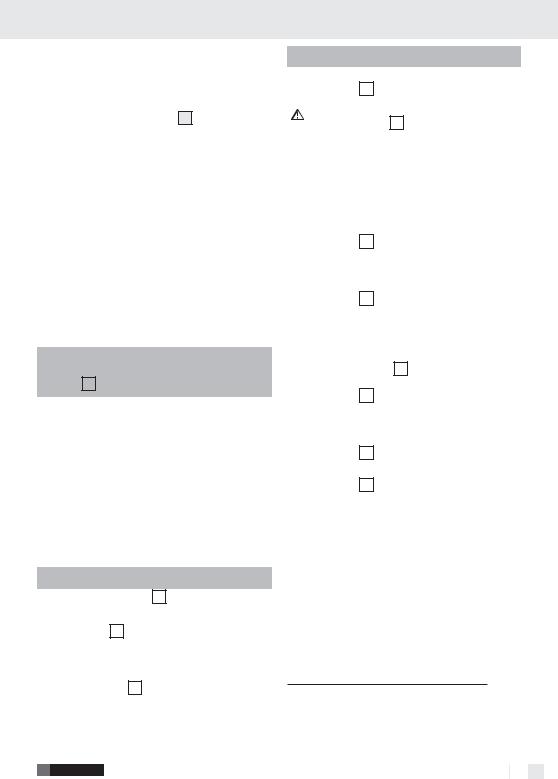
Advice on working with materials / Tools / Speed ranges
Use the highest speed when working on steel or iron with the milling bits 20 .
Use a short trial on a test piece to determine the optimum rotational speed range for working on zinc, zinc alloy, aluminium, copper and lead.
Use the low speed range for working on plastics and low-melting point materials.
Use high speeds on wood.
Use the medium speed range for cleaning, polishing and bu ng.
The following information shall be considered as recommendatory only. Learn by practical experience which tools and settings are the best for the materials you work with.
Setting the appropriate speed:
Symbols on |
Material to be |
||
ON / OFF |
worked on |
||
switch |
1 |
|
|
|
|
|
|
OFF |
(Drill / grinder switched o ) |
||
|
|
|
|
5 |
|
Plastics and low melting |
|
|
|
|
point materials |
7 |
|
Stone, Ceramics |
|
|
|
|
|
10 |
|
Softwood, metal |
|
|
|
|
|
17 |
|
Hardwood |
|
|
|
|
|
20 |
|
Steel |
|
|
|
|
|
Examples of appropriate tool selection Function:
Function |
Accessory |
Application |
||||||
|
|
|
|
|
|
|
|
|
Drilling |
HSS drill |
11 |
|
Drilling wood |
||||
|
|
|
|
|
|
|
|
|
Milling |
Milling bits |
Various tasks, e.g. |
||||||
|
|
20 |
|
|
|
|
|
hollowing out, |
|
|
|
|
|
|
|
|
gouging, shaping, |
|
|
|
|
|
|
|
|
grooving or slotting |
Engraving |
Engraving |
Making marks, |
||||||
|
bits |
21 |
|
craft projects |
||||
|
|
|
|
|
|
|
|
(see Fig. D) |
Operation / Maintenance and cleaning
Function |
Accessory |
Application |
||||||
|
|
|
|
|
|
|
|
|
Polishing, |
Metal brush |
Derusting |
||||||
derusting |
|
15 |
|
|
|
|
|
|
|
|
|
|
|
|
|
|
|
|
Polishing |
Working on vari- |
||||||
CAUTION! |
wheel |
13 |
|
|
ous metals and |
|||
|
|
|
|
|
|
|
plastics, in particu- |
|
Use only the |
|
|
|
|
|
|
|
|
|
|
|
|
|
|
|
lar noble metals |
|
lightest con- |
|
|
|
|
|
|
|
|
|
|
|
|
|
|
|
like gold or silver |
|
tact pressure |
|
|
|
|
|
|
|
|
|
|
|
|
|
|
|
(see Fig. E) |
|
of the tool on |
|
|
|
|
|
|
|
|
|
|
|
|
|
|
|
|
|
the work- |
|
|
|
|
|
|
|
|
piece. |
|
|
|
|
|
|
|
|
Cleaning |
Plastic brush |
E.g. cleaning com- |
||||||
|
|
19 |
|
|
|
|
|
plex plastic hous- |
|
|
|
|
|
|
|
|
ings or the area |
|
|
|
|
|
|
|
|
around a door lock |
|
Metal brush |
E.g. cleaning cut- |
||||||
|
|
15 |
|
|
|
|
|
lery, jewellery, |
|
|
|
|
|
|
|
|
tools (The metal |
|
|
|
|
|
|
|
|
brush is softer than |
|
|
|
|
|
|
|
|
steel) |
Grinding |
Grinding |
Grinding work on |
||||||
|
wheels |
14 |
, |
stone, wood; fine |
||||
|
grinding |
bits |
work on hard mate- |
|||||
|
|
22 |
|
|
|
|
|
rials such as ceramic |
|
|
|
|
|
|
|
|
or alloyed steel |
|
|
|
|
|
|
|
|
(see Figs. F, G) |
Cutting and |
Cutting discs |
Cutting metal, |
||||||
sawing |
|
17 |
|
|
|
|
|
plastic or wood |
|
|
|
|
|
|
|
|
|
|
Saw blade |
Saw blade, Saw- |
||||||
|
|
16 |
|
|
|
|
|
ing steel, metal, |
|
|
|
|
|
|
|
|
wood or plastic |
|
|
|
|
|
|
|
|
(see Fig. H) |
Tips and tricks
If you use press too hard you run the risk of breaking the tool or damaging the workpiece. You will achieve the best results by operating the tool at a constant rotational speed and using a low contact pressure on the workpiece.
Maintenance and cleaning
The device is maintenance-free.
Clean all the dirt o the drill / grinder. Use a dry cloth for cleaning.
GB/IE 11

Service / Warranty / Disposal
Service
 WARNING! Have your device repaired at the service centre or by qualified specialist personnel using original manufacturer parts only. This will ensure that your device remains safe to use.
WARNING! Have your device repaired at the service centre or by qualified specialist personnel using original manufacturer parts only. This will ensure that your device remains safe to use.
 WARNING! If the plug or lead needs to be replaced, always have the replacement carried out by the manufacturer or its service centre. This will ensure that your device remains safe to use.
WARNING! If the plug or lead needs to be replaced, always have the replacement carried out by the manufacturer or its service centre. This will ensure that your device remains safe to use.
GB
DES UK LTD
Tel.: 0871 5000 700 (£ 0.10 / minute) e-mail: support.uk@kompernass.com
IE
Kompernass Service Ireland
Tel: 1850 930 412 (0,082 EUR/Min.) Standard call rates apply. Mobile operators may vary.
e-mail: support.ie@kompernass.com
Warranty
The warranty for this appliance is for 3 years from the date of purchase. The appliance has been manufactured with care and meticulously examined before delivery. Please retain your receipt as proof of purchase. In the event of a warranty claim, please make contact by telephone with our Service Department. Only in this way can a post-free despatch for your goods be assured.
The warranty covers only claims for material and maufacturing defects, but not for transport damage, for wearing parts or for damage to fragile components, e.g. buttons or batteries. This product is for private use only and is not intended for commercial use.
The warranty is void in the case of abusive and improper handling, use of force and internal tampering not carried out by our authorized service branch. Your statutory rights are not restricted in any way by this warranty.
The warranty period will not be extended by repairs made unter warranty. This applies also to replaced and repaired parts. Any damage and defects extant on purchase must be reported immediately after unpacking the appliance, at the latest, two days after the purchase date. Repairs made after the expiration of the warranty period are subject to payment.
Disposal
The packaging is wholly composed of environmentally-friendly materials that can be disposed of at a local recycling centre.
Do not dispose of electric tools in the household waste!
In accordance with European Directive
2002 / 96 / EC about waste electrical and electronic equipment and its transposition into national legislation, worn out electric tools must be collected separately and taken for environmentally compatible recycling.
Please contact your municipal or city council to ask about how to dispose of old electrical tools.
12 GB/IE
